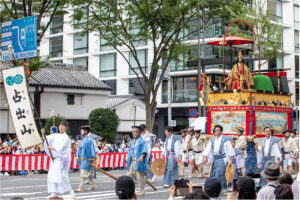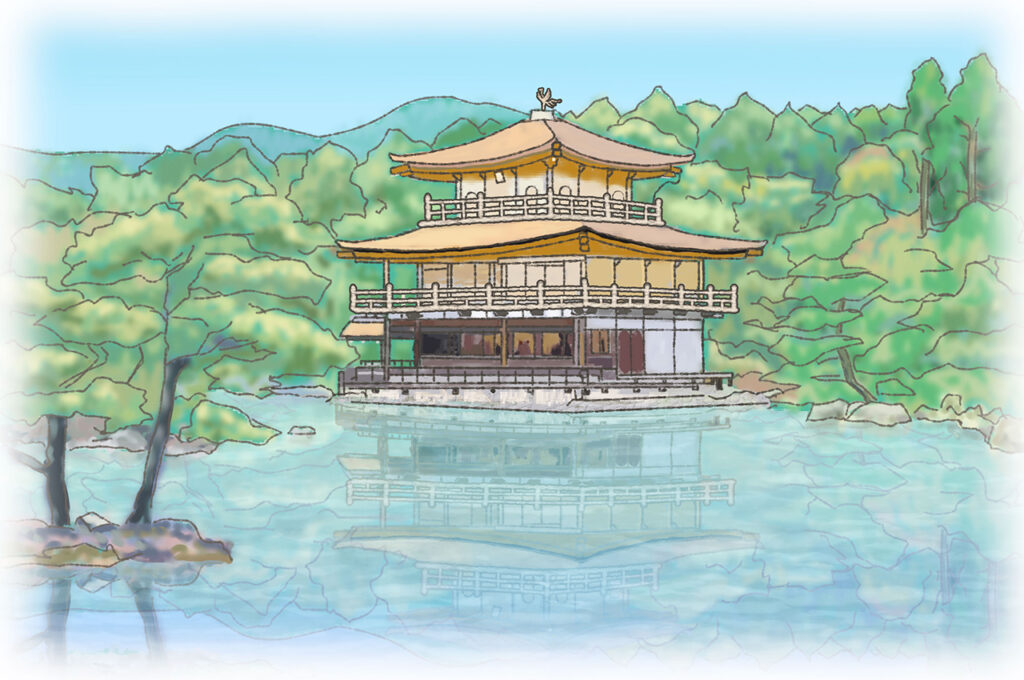


Kinkakuji Temple is one of the most famous sightseeing spots in Kyoto, where many visitors come to take a glimpse of its golden and glittering appearance. Kinkakuji Temple is a pagoda temple of the Shokokuji School of the Rinzai Sect of Zen Buddhism, and its official name is Rokuonji Temple. Kinkaku-ji is called "Kinkaku-ji" because of its famous "Kinkaku" (Golden Pavilion), and is well known not only by locals but also by students on school excursions and foreign tourists.
The trees in the expansive garden add seasonal color, delighting visitors with beautiful scenery that feels fresh no matter how many times they visit.
This section introduces the history of Kinkakuji from its founding to its suffering, the particular style of the Shariden Hall, and highlights of the temple grounds.
It is known that Ashikaga Yoshimitsu, the Muromachi Period Shogun, founded the temple, but its predecessor dates back to 1224 (Genin-era) of the Kamakura Period (1185-1333). The Saionji family, a powerful family at that time, built a grand villa in this area. When the Kamakura Shogunate fell, the Saionji family gradually declined, and Yoshimitsu took over the dilapidated villa.
In 1397 (Oei 4), Yoshimitsu began major renovations and built Kitayama-den (Kitayama Hall), which featured a garden and architecture centering on the Shariden and Kinkaku (Golden Pavilion), representing the Pure Land of Ultimate Bliss. The government affairs that had been conducted at Muromachi-den, Yoshimitsu's residence, were now conducted at Kitayama-den, and he also focused on trade, welcoming imperial envoys from Ming Dynasty China at Kitayama-den. In 1408, Emperor Go-Komatsu held a grand banquet at Shariden, which had been elaborately decorated with Chinese culture. It is said that Yoshimitsu, who developed the gorgeous Kitayama culture, used the Shariden as a guest house until the end of his life at the age of 51.
Later, in accordance with his last will and testament, Kitayama-den became a Zen temple and was named [Rikaen-ji] after Yoshimitsu's Buddhist name, Rikaen-in-den.
During the Onin War of 1467, many temples were burnt down and most of Rokuonji Temple was destroyed by fire, but miraculously, the Shariden and other buildings escaped damage. After the tumultuous Azuchi-Momoyama period, the country entered the peaceful Edo period (1603-1868). At the order of Tokugawa Ieyasu, Seisho Jyotai, a priest from Shokokuji Temple who was a valued political advisor, became the abbot of the temple and began its restoration. In the Meiji era (1868-1912), the temple lost its supporters, and with the abolition of Buddhism, it faced difficulties, but it has been open to the public since 1894 (27th year of Meiji), and has continued to exist by using the admission fee to cover maintenance costs.
The first thing that greets you as you proceed along the approach full of greenery is the main gate, Somon-mon (main gate). The first thing to check out here is the earthen wall extending next to the gate. It is marked with five lines, which are used as a symbol of the Imperial Palace and the monzeki temples. There are three levels of lines, from three to five, depending on the level of prestige, with five lines being the highest.
Also, on the round kawara tile of the gate, you can see the inscription of the historic family crest, 57 paulownia (paulownia), which was bestowed by the emperor's family. When you count the ruler lines, look up at the temple crest, and go through the gate with your mind in the right direction.
After passing through the Karamon Gate, visitors will see a three-story golden pavilion standing as if floating on a pond. The Shariden and Kinkaku, the representative buildings of Rokuonji, are estimated to have been completed in 1399 (Oei 6).
Shariden is a building in which the remains of the Buddha, the stupa, are enshrined. The first level, Hosui-in, enshrines a statue of the Hogan Shakyamuni Buddha and is built in the shinden-zukuri style used in the residences of aristocrats during the Heian period (794-1185). The two-story Choon-do is the Kannon-den, and is built in the buke-zukuri style, which was the residential style of samurai families in the Kamakura period. The third level, Kukyoucho, where Buddhist relics are housed, is a Chinese-style Zen Buddhist temple, with gold leaf applied to the pillars and ceiling, as well as the floor.
In fact, the Shariden was burned down in an arson attack in 1950. The seated statue of Yoshimitsu and Kannon Bosatsu were also lost in the fire. The present structure was rebuilt in 1955 with a total weight of 20 kg of gold. The gold leaf on the exterior walls, which is applied on the second and third levels, has since been peeling off due to ultraviolet rays and deterioration, and the building underwent a major Showa restoration in 1986.
Even more remarkable is the phoenix standing at the top of the roof, facing south. Fortunately, the phoenix from the time of the temple's founding remains, as it was stored elsewhere for restoration when the Shariden was destroyed by fire. Since it is the only relic preserved in the temple, it is not possible to see it, but we would like to look at the phoenix standing in its place, thinking of the many hardships it has endured and the reconstruction of the temple.
Kyokko Pond, which spreads out in front of the Shariden and Kinkakuji Pavilions, is the centerpiece of the Rokuonji Garden, a pond garden with a circular garden system. As the name implies, the reflection of the Shariden on the mirror-like clear surface of the water is called "Gyakusasaikaku (upside-down Golden Pavilion). The pond is about 2,000 tsubo in area, and is surrounded by islands of various sizes, including Reedwara-jima Island, as well as other oddly shaped rocks and stones.
It is said that such a mirrored lake pond was built in imitation of the Shippoike pond depicted in the Mandala of the Pure Land. Shippoike is said to be made of seven kinds of gems: gold, silver, lapis lazuli, crystal, coral, red pearl, and dark green jade.
The boat-shaped pine tree seen on the north side of the Hojo is said to have been planted by Yoshimitsu and is one of the three most beautiful pine trees in Kyoto. The tip of the pine tree, which is shaped like a sailing boat, points westward to express Yoshimitsu's wish to go to the Pure Land in the west on this boat.
Other historic sights include the Ginga Spring, which is said to have been used by Yoshimitsu for tea ceremony, and the Ryumon Falls, where water cascades down from a height of 2.3 meters. When you visit, take a walk while imagining the life of Yoshimitsu, who was prosperous at that time.
By bus from Kyoto Station
B3 boarding gate
Take the No. 205 bus bound for Kinkakuji/Kitaoji Bus Terminal, get off at Kinkakuji-michi bus stop, and walk 5 minutes.
By bus from Karasuma-Shijo Subway Station
Bus stop D (south side of Shijo St.)
Board the No. 12 train (bound for Kinkakuji or Ritsumeikan University) → alight at the Kinkakuji-michi bus stop → 5-minute walk
By bus from Imadegawa Subway Station
Bus stop B (south side of Imadegawa Dori)
Take the No. 59 bus (bound for Kinkakuji, Ryoanji, or Yamakoshi) → Get off at the bus stop "Kinkakuji-michi" → 5 minutes on foot
By bus from Kitaoji Subway Station
Kitaoji Bus Terminal G stop
Take the No. 204 bus bound for Kinkakuji or Enmachi→get off at the bus stop "Kinkakuji-michi"→5 minutes on foot
Kitaoji Bus Terminal, Bus Stop E
Take the No. 205 bus bound for Kinkakuji or Nishioji-Shijo→get off at the Kinkakuji-michi bus stop→5 min. walk.
Kitaoji Bus Terminal F stop
Route M1 (for Kinkakuji/Haraya) → get off at bus stop "Kinkakuji-michi" → 5 min. walk
Parking lot (passenger cars)
Number of vehicles / 250 (total of parking lots 1-3)
Hours of operation / 8:40 a.m. to 5:10 p.m.
Fee: 400 yen for up to 1 hour, 200 yen per 30 minutes thereafter
Over 600 interviews per year! An order site carefully selected by the editors who knows Kyoto and Shiga.
nowOfficial LINE friend registration500 yen OFF coupon is being issued!
Distributed every Friday morning at 8:00 am! From new restaurant information to event information that we want to share with you, We deliver articles about Kyoto that are useful to know. About 20,000 people have registered.Click here to add a friend!
 News
News Feature article
Feature article Featured event
Featured event